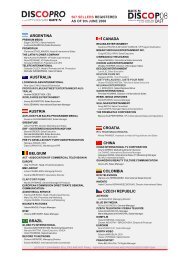discop link • #11
discop link • #11
discop link • #11
- No tags were found...
You also want an ePaper? Increase the reach of your titles
YUMPU automatically turns print PDFs into web optimized ePapers that Google loves.
CONFERENCEThe IBC Conference opened withthe "Broadcasting by Broadband"theme day. Sessions included "Wiredand Wireless Technologies and IPTV","The Future of Broadband BroadeventdossierIBC 2007By Sinisa IsakovIn early September Amsterdam in The Netherlands hosted yet anotheredition of IBC. Between September 6 th -11 th , at the conference and thetechnical exhibition, as well as at the accompanying events, almost50,000 people passed through the Amsterdam RAI Centre.Although this was IBC's 40 th anniversary,there was neither anyparticular celebration nor retrospectionto its past. Thanks to new technologies,the industry is spreading intonew fields, and IBC does its best tomaintain its importance as the relatedannual event. There were a total of1,360 exhibitors, an increase of 5%.The number of visitors also increasedwhen compared to last year, and whatpleases the organisers most is thefact that, after many years of stagnation,there was a significant increasein visitors from Central and EasternEurope. Although their share in thetotal number of visitors is still underten percent, there are indications thatbroadcasting will develop more quicklyin the forthcoming period.And what is the name of the industrytoday? Not long ago, IBC itselfabandoned its full title - the InternationalBroadcasting Convention - andreplaced it with IBC. 'Electronic media'is a term that was for some time quiteappropriate, as was the term 'multimedia'.Recently, there has been agrowing number of supporters of thesystem 'media and entertainment'promoted, among others, by IBM andMicrosoft. Currently it seems to bethe best description of the industrywhich, in addition to one-way terrestrialbroadcasting, also includes IPTVand Mobile TV, together with the innovationsthat will follow the convergencewith IT technology.The twenty pavilions in the RAICentre were not enough to host all theinterested exhibitors. Therefore a separatepavilion was dedicated to IPTVdevices. The Mobile and IPTV Zones,on the other hand, were located onthe premises of the former IBCRestaurant. The success of thesezones heralded the era to come. Let itbe noted that IBC launched the zonesin order to promote future technologieswhich are partially available and,to varying degrees, still in the developmentphase. At numerous microstandsthe producers were given theopportunity to present prototypedevices, to meet end users andexchange ideas and attitudes withthem and maybe to make agreementsregarding testing and trials. Theresult was something half way betweena conference and an exhibition,something which has proved to be asuccess.IPTV technology is used by deviceproducers both small and large, but aparadox is that interest in the IPTVZone is even greater. In fact, the interesthas shifted from the technologyitself toward the development of abusiness model, that is to say, towardsthe application of technology inpractice. Apart from broadcastersand content creators, important partnersalso include cable operators andthe telecommunications industry. Thecommon topic of all discussion andthe IPTV business model developmentprocess is the creation of the contentitself: How to create a sufficient quantityof top quality content, particularlyinteractive content which is appropriatefor IPTV distribution, is a challengeshared by all of the parties involved.IPTV technology is, to a largeextent available, both for SD and HDvideo quality distribution, to the enduser over a broadband network.Further development of compressiontechniques will make the increase inthe number of channels within thesame cable possible, not to mentionthe improvement of the video signalquality. It is inevitable that HDTV will,apart from satellite distribution, soonfind its place within IPTV distributionas well, and that will happen evenbefore complex regulations are adoptedto enable HDTV distribution via terrestrialbroadcasting.A similar scenario was seen withthe Mobile Zone. As many as three differenttechnologies are available,each of them having their advantagesand disadvantages, and all three aremature and ready for application. Inrecent years dozens of trials havebeen performed, one even during IBC2007 in Amsterdam, so there are notechnological uncertainties. However,one large question has been posed:How do mobile users actually consumevideo and TV content today? Theanswer to that question should be ofgreat help in finding a perfect contentfor Mobile TV. Together with the contentcreators, broadcasters also seekthe answer to this question, that theymight open their archives to MobileTV. Telecommunication operators andreceiver device manufacturers arealso standing by, ready to plunge intoMobile TV.56 DISCOP LINK <strong>•</strong> <strong>#11</strong> <strong>•</strong> NOVEMBER 07
















